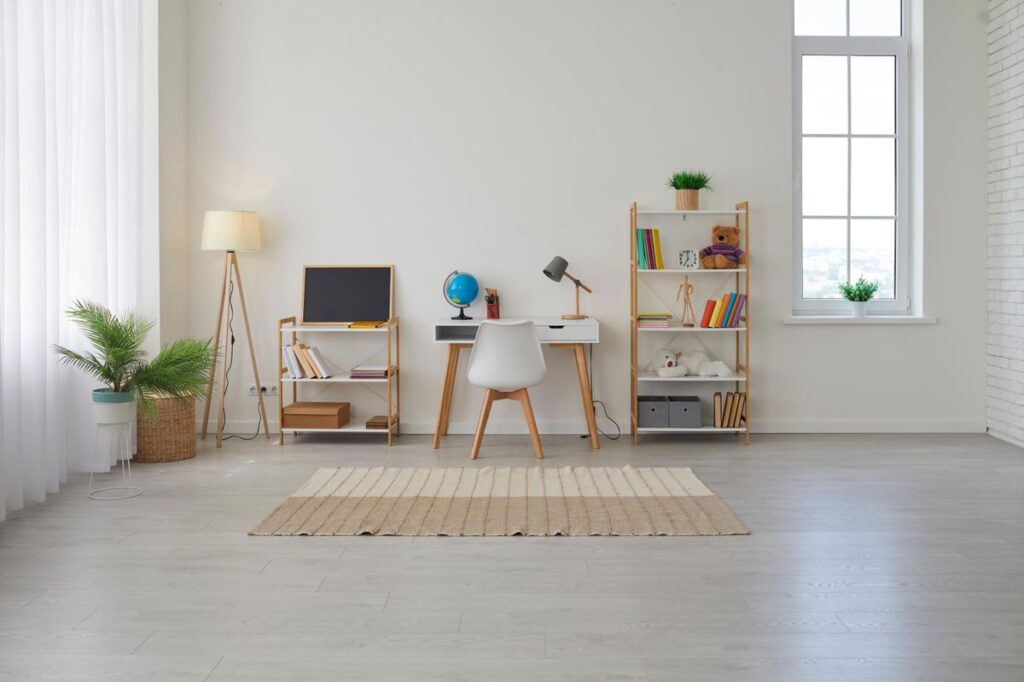In today’s fast-paced world, creating a study space that encourages focus, organization, and productivity is essential. One of the most effective ways to achieve this is by adopting a minimalist design for your study area. A minimalist approach reduces clutter, helps improve concentration, and creates a calm, streamlined environment. In this guide, we’ll explore how minimalist design principles can transform your study space, making it both functional and aesthetically pleasing.

1. The Essence of Minimalist Design
Minimalism is all about simplicity, clean lines, and functionality. The goal is to create a space that is free from unnecessary distractions while maintaining an elegant, clutter-free atmosphere. By focusing on the essentials and removing excess items, you can create an environment that promotes mental clarity, helping you stay focused and productive.
2. Choose a Neutral Color Palette
A minimalist study space often features a neutral color palette that promotes calmness and clarity. Light, neutral colors like white, beige, soft grays, and pastel tones are ideal for creating a peaceful atmosphere. These colors reflect light, making your study area feel more open and spacious. Additionally, neutral tones are versatile and allow you to add subtle pops of color through accessories without overwhelming the space.
- Walls: Opt for soft whites or light grays to keep the space airy and bright.
- Furniture: Choose furniture in neutral colors like white, black, or natural wood finishes to maintain simplicity.
- Accents: Add minimal accents in subtle tones, such as a potted plant, a simple vase, or a muted piece of artwork.
3. Declutter and Organize
The foundation of any minimalist design is decluttering. A clutter-free environment promotes focus and reduces stress. Start by clearing your study space of unnecessary items and only keep what is essential for your studies. Here’s how to organize your space:
- Minimal Furniture: Invest in functional, space-saving furniture pieces. A simple desk with clean lines and a comfortable, ergonomic chair are all you need. Avoid bulky or overly decorative furniture that may distract from your purpose.
- Storage Solutions: Keep your study materials organized with minimalist storage solutions. Use storage bins, shelves, or boxes to keep books, stationery, and other items out of sight. Opt for simple, stackable organizers that blend seamlessly with your décor.
- Paper Management: Minimize paper clutter by going digital where possible. Use online note-taking apps or cloud storage for easy access to study materials. For important papers, use a small filing system or a minimalistic drawer to store them neatly.
4. Opt for Multi-Functional Furniture
When working with limited space, choosing multi-functional furniture can help keep your study area organized while minimizing visual clutter. Look for pieces that serve more than one purpose, such as:
- A Desk with Storage: Look for desks that come with built-in drawers or shelving to store your study materials, electronics, or supplies. This reduces the need for additional furniture and keeps the space tidy.
- Foldable Furniture: If you have a small study space, consider foldable or wall-mounted furniture. A wall-mounted desk or fold-out table allows you to save space when not in use, giving you a clutter-free area.
- Ergonomic Chairs with Built-in Storage: Some minimalist ergonomic chairs come with additional storage under the seat or have built-in pockets for easy access to your study essentials.
5. Incorporate Natural Elements
One of the key features of minimalist design is the use of natural elements to enhance the aesthetic and create a serene environment. By incorporating plants and natural materials, you can add a touch of life to your study space without cluttering the area.
- Indoor Plants: Plants like succulents, cacti, or a small potted plant on your desk can add freshness and a calming effect to your study environment. Opt for simple, modern planters that match your minimalist theme.
- Natural Materials: Use furniture or accessories made from natural materials such as wood, stone, or bamboo. A wooden desk or a stone lamp adds warmth to the space while maintaining the minimalist vibe.
- Natural Light: Maximize natural light by positioning your desk near a window. Natural light not only brightens the space but also boosts mood and productivity.
6. Keep Your Technology Neat
In a minimalist study space, technology should blend into the environment rather than dominate it. Here’s how to keep your tech organized and tidy:
- Hide Wires: Use cable organizers or cable trays to keep all your cords and wires neatly hidden. This prevents cables from tangling and creating visual clutter on your desk.
- Wireless Devices: Opt for wireless keyboards, mice, and headphones to minimize the number of cords on your desk.
- Tech Storage: Store your devices and accessories in dedicated drawers or boxes when not in use. This keeps your desk clear and ensures that technology does not overwhelm your space.
7. Choose Simple, Functional Decor
Decor in a minimalist study space should enhance the environment without overwhelming it. Stick to a few well-chosen, functional decor pieces that serve a purpose and align with the minimalist aesthetic.
- Artwork: Choose simple, abstract artwork or minimalist prints that add personality to your study space without drawing attention away from your work. A single framed print or a small piece of art can serve as a focal point.
- Lighting: Lighting is an essential part of a minimalist study space. Choose simple, modern light fixtures that complement the overall design. A sleek desk lamp with adjustable brightness can provide adequate light without adding visual clutter.
- Functional Accessories: Consider adding small, useful accessories such as a timer to track study sessions or a minimalist clock to keep track of time. These items serve a purpose while contributing to the clean, organized look of the space.
8. Create Zones for Focus and Relaxation
If you have the space, consider creating separate zones within your study area for different activities. By dividing your space into focused zones, you can create a more organized and effective environment.
- Study Zone: This should be your main work area, with a clean desk, ergonomic chair, and all the essentials for studying. Keep the space free of distractions, and make sure everything is within reach.
- Relaxation Zone: If possible, create a small relaxation zone within the study space. A comfortable chair or cushion can provide a space for breaks or mindfulness exercises. This separation can help maintain focus during study sessions and provide a mental break when needed.
9. Mindful Use of Color and Texture
While a minimalist design often favors neutral tones, you can add depth and interest to your study space through the careful use of color and texture. Instead of cluttering the space with multiple colors, focus on one or two accent tones to enhance the atmosphere.
- Accent Colors: Introduce one or two accent colors through decor items such as a throw blanket, a cushion, or a vase. Soft shades of blue, green, or mustard can evoke calm and creativity.
- Textures: Incorporate textures that add warmth to the space without overwhelming it. A soft wool rug, a smooth wooden desk, or a stone lamp can provide tactile contrast while maintaining a minimalist aesthetic.
10. Maintain Regular Cleaning and Upkeep
A minimalist study space requires regular maintenance to keep it organized and free from clutter. Set aside time each day or week to tidy up your space, put away study materials, and organize your desk.
- Daily Cleaning: Wipe down surfaces, put away any books or materials, and check for any cables that need to be hidden or rearranged.
- Organize Regularly: Keep your study space fresh by periodically reassessing what you need and removing items that no longer serve a purpose.

Conclusion
Transforming your study space with minimalist designs can have a profound impact on your concentration and productivity. By embracing simplicity, decluttering, and focusing on functionality, you create a calm, organized environment that encourages deep focus and efficiency. The minimalist approach is not just about aesthetic appeal but about creating a space that supports your study goals and enhances your well-being. By incorporating clean lines, neutral colors, natural elements, and thoughtful organization, you can create a study space that inspires and empowers you to succeed.


